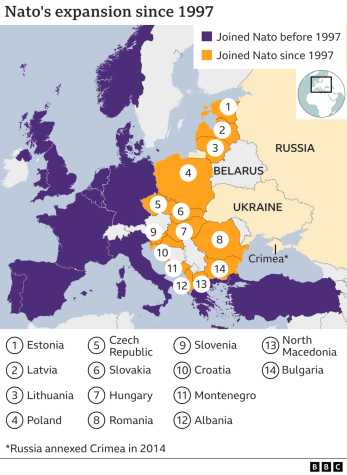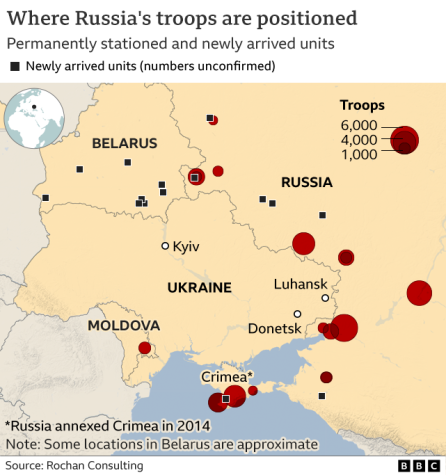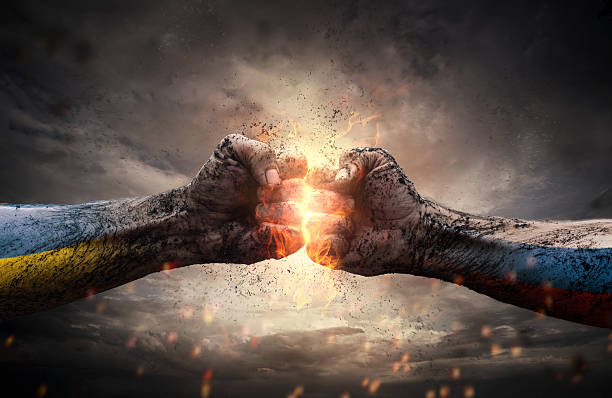Ukraine-Russia Crisis: A Simplistic Explanation of Current Events
February 1, 2022
Lost on recent news? Why are Ukraine’s NATO ambitions so controversial? Could war break out? NATO, The United States, and Russia have been caught in a frenzy of diplomacy to prevent Europe’s most significant military action since World War II. Here’s a breakdown of what’s at risk.
NATO (North Atlantic Treaty Organization) allies, fearful of an invasion by Russia, have stepped up to support Ukraine by sending troops and military equipment. The alliance declares that this act responds to Russia’s continued military buildup all along the border of Ukraine.
Moscow claims that its actions are necessary to secure vital interests and further blames NATO for undermining the region’s security. Ukraine was a part of the Russian empire for centuries, then later became a Soviet republic. As the USSR broke up in 1991, Ukraine won independence from Russia. Ukraine’s goal was to release ties with the Russian Imperial Legacy and forge closer ties with the West.
Tensions between Ukraine and Russia have been burning up since 2014 – when Ukraine ousted its pro-Russian President Viktor Yanukovych after he rejected an agreement with the European Union in the hopes of forming closer connections with Moscow. This was a mistake on his part, as it led to protests that saw him removed as the Ukrainian leader. Russia’s response came by annexing Ukraine’s Crimean Peninsula and throwing its force behind a separatist rebellion in Ukraine’s East. Moscow then denied Ukraine and the West’s accusations, claiming that Russia sent troops and weapons back the rebels. Their claim in defense was that the Russians who joined the insurgents had volunteered. A cease-fire was established in 2015, but peace remained challenging during a bloody conflict that has killed over 13,000 military and civilians.
According to Kyiv, more than 14000 people have died in the fighting that devastated Donbas, the Eastern Industrial Heartland of Ukraine.
Moscow has strongly criticized the U.S. and the NATO allies for aiding Ukraine with weapons and holding joint drills, saying that the acts encourage the Ukrainian hawks to regain the rebel-held areas. In addition, Russian President Vladimir Putin has repeatedly claimed that Ukraine’s goals to join NATO are a red line, expressing his concern about plans that some NATO members have about setting up military training centers in Ukraine. Putin further states that this would hand out a military foothold in the region without Ukraine joining NATO.
This conflict isn’t about what Russia wants; it’s about what Russia seeks to prevent. Russia does not want Ukraine to join NATO and has said this in its list of security demands sent to the U.S. last December. This list also included the need to halt any NATO drills near Russia’s border. It also wants NATO to cease any expansion in Eastern Europe.
In December, Putin sought out assurances “that would exclude any further NATO moves eastward and the deployment of weapons systems that threaten us in close vicinity to Russian territory.” He then offered the West the opportunity to engage in conversations about this issue, adding that he did not just seek out verbal claims but “legal guarantees”.

NATO and the United States have now responded to this, but neither Moscow nor the West has gone public with the details of the responses. Although the public is not aware of the specifics, one thing was made clear. Russia’s central demands essentially request for Ukraine to be banned from becoming a member of NATO and a promise that the alliance will not extend further into the East. This was denied.
Ukraine does indeed have wishes to join NATO, and although Ukraine is not a member, it is considered a partner of the alliance. NATO Secretary-General Jens Stoltenberg in December denied Russian demands to revoke a commitment from 2008 to Ukraine that the country would one day find itself a member. When the event arises to consider the situation, he says that Russia will have no hand in vetoing Ukraine’s ascension.
The United States and NATO allies are reluctant to expand their military footprint into the region, fearful of further jeopardizing their relationship with Moscow. So while U.S. Secretary of State Antony Blinken voiced support for Ukraine’s membership in NATO, President Joe Biden has been more unclear on the question.
The heat rises as the West accuses Russia, which has amassed 100,000 troops on the Ukrainian border, of preparing to invade. The Pentagon has placed 8,500 US troops on standby for an Eastern European deployment, and NATO revealed that it was sending ships and jets to bolster the region’s defenses.
Russia denies any plans to invade Ukraine and claims that the West is just aggravating the situation by making these moves.
“The United States is escalating tensions,” said President Putin’s spokesman (Dmitry Peskov). “We are watching these U.S. actions with great concern.”
The situation intensified over the weekend as President Biden considered deploying several thousand U.S. troops, warships, and aircraft to NATO allies in the Baltics and Eastern Europe.

What would happen if Russia was to invade?
Publicly, the U.S. and European allies have claimed that they will punish Russia financially if Putin advances into Ukraine. In addition, Washington and London have spoken of subjective measures targeting the Russian president. For example, The U.S. holds one of the most potent financial weapons against Putin if he invades Ukraine – blocking Russia from accessing the U.S. dollar. Dollars still dominate in financial transactions worldwide, with trillions of dollars in play daily. In addition, the U.S. is considering potentially cutting Russia off from the high tech that assists warplanes, passenger jets flying, and powers other technologies.







